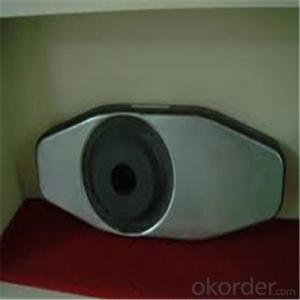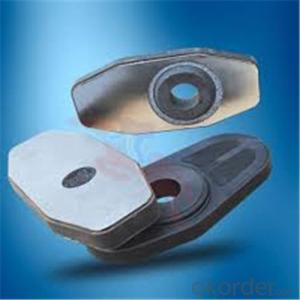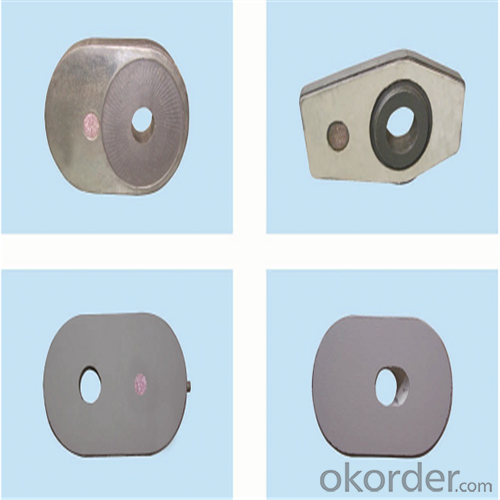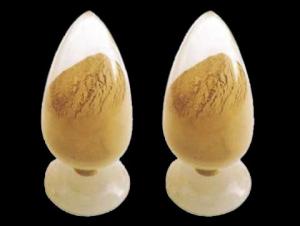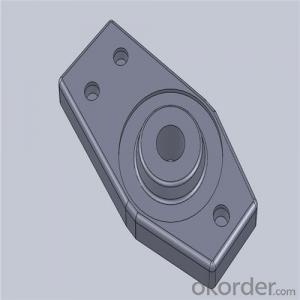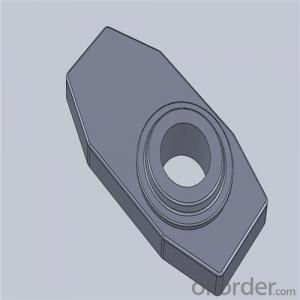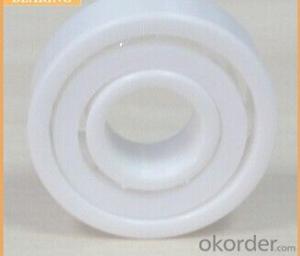Monolithic Refractories High Temperature Ladle Sliding Gate for Iron and Steel Industry
- Loading Port:
- Shanghai
- Payment Terms:
- TT OR LC
- Min Order Qty:
- 100 pc
- Supply Capability:
- 1000 pc/month
OKorder Service Pledge
OKorder Financial Service
You Might Also Like
Quick Details for High Performance Refractory Ladle Slide Gate
| Place of Origin: | China (Mainland) | Shape: | Plate | Material: | Alumina Block |
| SiO2 Content (%): | N/A | Al2O3 Content (%): | 80-90% | MgO Content (%): | N/A |
| CaO Content (%): | N/A | Refractoriness (Degree): | 1770°< Refractoriness< 2000° | CrO Content (%): | N/A |
| SiC Content (%): | N/A | Model Number: | CS80 | Brand Name: | |
| Product name: | High performance refractory ladle slide gate | Model No.: | cs80 | Brand name: | CMAX |
| Quality: | Al-C or Al-Zr-C | Service life: | 4-6 heats | Apparent porosity: | 7% Max |
| Bulk density:: | 3.1 MIN | C.C.S: | 120MPA | MOQ: | 100 pcs for trial |
| Delivery time: | 60 working days upon receipt of deposit |
Packaging & Delivery
| Packaging Details: | Inner carton packing, outer wooden case suitable for long term sea shipping |
| Delivery Detail: | three months working days upon receipt of deposit |
Specifications
Surface flatness less than 0.05mm
High mechanical strength
Erosion resistance
Oxidation resistance
Thermal shock stability
General Chemical Analysis for refractory ladle slide gate :
slide gate plate widely including Alumina carbon and Alumina Zirconia Carbon slide gate plate, MgO and MgO-spinel slide gate plate,nonoxides bonding slide gate plateand unburned slide gate plate.
Alumina -Zirconia-Carbon material
| Al-Zr-C Material | |||||
| Al2O3 | C | ZrO2 | Apparent porosity | Bulk density | C.C.S |
| (% minm) | (% minm) | (% minm) | (% max) | (gm./cc minm) | (MPa minm) |
| 85 | 3 | 5 | 7 | 3.1 | 120 |
| 85 | 3 | 4 | 7 | 3.1 | 120 |
Composite type: Al-Zr-C for working line, outer Al-C material

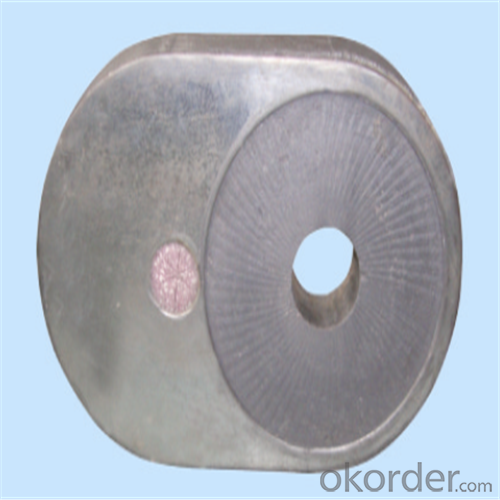


| Al-Zr-C & Al-C Material | ||||||
| Al2O3 | C | ZrO2 | Apparent porosity | Bulk density | C.C.S | |
| (% minm) | (% minm) | (% minm) | (% max) | (gm./cc minm) | (MPa minm) | |
| Inner side (Working face) | 85 | 3 | 4 | 7 | 3.1 | 120 |
| Outside | 90 | 3 | 0 | 9 | 3 | |
Using the raw materials of tabular alumina, zirconia-corundum, carbon and other high-grade additives, after sintering to obtain characteristics of oxidation resistance, scour strength, erosion resistance, thermal shock resistance, shape stable and long service life, made our products the preferred materials for the large and medium-sized steel ladle, refining ladle, series of alloy steel ladle, and tundish. Our high performance sintering sliding gates include alumina carbon , Al2O3-ZrO2-C, etc, can meet the needs of different steel grade.
Other Products

About us


Sample is on your request.
Welcome to visit our factory~
- Q: What are the main factors affecting the thermal expansion of monolithic refractories?
- The thermal expansion of monolithic refractories is influenced by various factors. These factors comprise the type of refractory material, the temperature range, the chemical composition, and the physical structure of the refractory. To begin with, the thermal expansion behavior of a refractory is significantly determined by its type of material. Different types of refractories, such as alumina-based, silica-based, and magnesia-based refractories, possess varying coefficients of thermal expansion (CTE). For instance, alumina-based refractories generally exhibit a lower CTE in comparison to silica-based refractories. Consequently, the choice of refractory material holds great influence over its thermal expansion characteristics. Secondly, the thermal expansion of a refractory is affected by the temperature range to which it is exposed. As the temperature rises, the refractory material expands due to the absorption of thermal energy. However, different refractories demonstrate different expansion behaviors depending on temperature. Some refractories may exhibit a linear or near-linear expansion with temperature, while others may display non-linear or step-wise expansion. Hence, the temperature range of operation is a critical factor in determining the suitability of a refractory for a specific application. The chemical composition of the refractory also has an impact on its thermal expansion. The presence of various chemical elements and compounds in the refractory material can influence its expansion behavior. For instance, the addition of specific oxides, like magnesia or zirconia, can modify the CTE of the refractory. Similarly, impurities or variations in the chemical composition can introduce discrepancies in expansion characteristics among refractories of the same type. Lastly, the physical structure of the refractory, encompassing factors such as porosity, density, and microstructure, can influence thermal expansion. The existence of open or closed pores within the refractory can affect its ability to expand uniformly under thermal stress. The density of the refractory also plays a role, as denser refractories tend to have lower thermal expansion. Moreover, the microstructure, including grain size and orientation, can impact the overall expansion behavior of the refractory. To conclude, the primary factors influencing the thermal expansion of monolithic refractories include the type of refractory material, temperature range, chemical composition, and physical structure. A comprehensive understanding of these factors is crucial in selecting the appropriate refractory for a specific application to ensure optimal performance and durability.
- Q: In iron and steel industry, the main raw materials for blast furnace ironmaking are iron ore, coke and limestone. What's the use of limestone here?
- CaCO3 CaO + CO2 =C = 2CO + CO2Fe2O3
- Q: How do monolithic refractories contribute to the overall productivity of iron and steel production?
- The overall productivity of iron and steel production is greatly enhanced by the use of monolithic refractories. These refractories are crucial components utilized in the lining of high-temperature furnaces and other equipment employed in these industries. One of the ways in which monolithic refractories boost productivity is through their exceptional thermal insulation capabilities. By possessing high thermal conductivity, they effectively minimize heat loss from the furnaces, thereby reducing energy consumption and enhancing overall efficiency. This insulation property permits higher operating temperatures, resulting in faster and more efficient production processes. Furthermore, monolithic refractories exhibit superior resistance to thermal shock and chemical corrosion. Given the harsh conditions experienced during the iron and steel production process, such as rapid temperature fluctuations and exposure to molten metal and slag, these refractories are designed to withstand such extreme environments. This ensures prolonged service life and decreased downtime for maintenance and repairs, directly leading to increased productivity and reduced production costs. Additionally, monolithic refractories offer improved dimensional stability in comparison to traditional brick refractories. Their ability to conform to intricate shapes and structures allows for enhanced lining design, facilitating superior heat transfer and distribution. This uniformity in heat distribution contributes to improved process control and greater consistency in product quality. Moreover, the installation and repair of monolithic refractories are relatively simpler and quicker when compared to traditional brick refractories. This ease of installation and repair reduces downtime during maintenance, enabling more continuous production. The decreased downtime ultimately leads to increased productivity and higher output. In conclusion, monolithic refractories significantly contribute to the overall productivity of iron and steel production through their excellent thermal insulation, resistance to thermal shock and chemical corrosion, improved dimensional stability, and ease of installation and repair. These properties result in enhanced energy efficiency, reduced downtime, improved process control, and higher product quality, ultimately leading to increased productivity and profitability for the industry.
- Q: How do monolithic refractories withstand the alkali attacks in cement kiln applications?
- Due to their unique composition and structure, monolithic refractories are capable of withstanding alkali attacks in cement kiln applications. Unlike traditional brick refractories, these refractories are made from a single material, resulting in a more uniform and dense structure. When exposed to alkali attacks in cement kilns, monolithic refractories create a barrier against the corrosive alkali substances by forming a protective layer on the surface. This protective layer is formed through reactions between the alkali substances and the refractory material, leading to the development of a stable compound that resists further attacks. Additionally, monolithic refractories possess high chemical resistance, allowing them to endure the aggressive conditions inside cement kilns. Their low porosity design minimizes the infiltration of alkali substances into the refractory material, reducing the risk of alkali attacks and extending the lifespan of the refractory lining. Furthermore, monolithic refractories are frequently manufactured using materials with elevated melting points, such as alumina, silica, and magnesia. These materials exhibit exceptional thermal stability, enabling the refractories to withstand the high temperatures in cement kilns without significant deterioration. This thermal stability is crucial in preventing the formation of cracks and spalling, which could permit alkali penetration and subsequent harm to the refractory lining. In conclusion, monolithic refractories are specifically engineered to resist alkali attacks in cement kiln applications by forming a protective layer, possessing high chemical resistance, and demonstrating excellent thermal stability. These characteristics make them an ideal choice for lining cement kilns, ensuring long-term performance and durability.
- Q: What are the factors affecting the thermal expansion of monolithic refractories?
- The factors affecting the thermal expansion of monolithic refractories are the composition of the refractory material, the temperature gradient, and the firing or curing process.
- Q: How do monolithic refractories improve the efficiency of ladle and tundish preheaters?
- Monolithic refractories improve the efficiency of ladle and tundish preheaters by providing excellent insulation, high thermal conductivity, and resistance to thermal shock. These properties allow for better heat retention, reduced heat loss, and quicker and more uniform heating of the ladle and tundish, ultimately improving the overall efficiency of the preheating process.
- Q: What are the limitations of monolithic refractories in high-temperature applications?
- Monolithic refractories are renowned for their versatility and ease of installation, which has made them a popular choice in various high-temperature settings. However, it is important to take into account their specific limitations. To begin with, monolithic refractories have a restricted ability to withstand thermal shock. Significant temperature changes, such as those encountered during start-up or shutdown procedures, can subject them to thermal stress, resulting in cracking or spalling. This can be a significant issue in scenarios where the refractory is exposed to frequent temperature fluctuations. Moreover, monolithic refractories possess comparatively lower mechanical strength in comparison to traditional brick or block refractories. This can lead to a diminished ability to withstand mechanical stress, including abrasion or impact, particularly in high-temperature environments. Consequently, they may not be suitable for applications that involve high mechanical loading or abrasive conditions. Another drawback of monolithic refractories is their vulnerability to chemical attack. Certain aggressive chemical environments can trigger chemical reactions with the refractory material, leading to deterioration or corrosion. This becomes a concern in applications that involve acidic or alkaline substances, where specialized refractory materials may be necessary. Additionally, monolithic refractories are more susceptible to spalling or erosion caused by thermal cycling. The repetitive expansion and contraction of the refractory material due to temperature changes can result in the formation of cracks or gaps, making them more prone to erosion from gases or liquids. This limitation must be carefully considered in applications where long-term durability is crucial. Lastly, repairing or replacing monolithic refractories can be challenging compared to brick or block refractories. Once installed, removing and replacing a monolithic lining can prove difficult, especially in complex shapes or confined spaces. This limitation can lead to prolonged downtime or increased maintenance and repair costs. In conclusion, while monolithic refractories offer numerous advantages in high-temperature applications, they also come with limitations in terms of thermal shock resistance, mechanical strength, chemical resistance, erosion, and repairability. It is crucial to thoroughly assess these limitations to ensure the suitability of monolithic refractories for specific application requirements.
- Q: How can the lifespan of monolithic refractories be extended in the iron and steel industry?
- The lifespan of monolithic refractories can be extended in the iron and steel industry through proper installation, regular maintenance, and implementing effective refractory management practices. This includes using high-quality refractory materials, ensuring precise installation techniques, monitoring and controlling operating conditions, conducting regular inspections, and promptly addressing any signs of wear or damage. Additionally, optimizing heating and cooling cycles, implementing appropriate refractory lining designs, and incorporating advanced technologies can further enhance the longevity of monolithic refractories in this industry.
- Q: How do monolithic refractories contribute to the safety of iron and steel plants?
- Monolithic refractories play a crucial role in ensuring the safety of iron and steel plants. These refractories are specially designed to withstand high temperatures, chemical attacks, and mechanical stresses commonly encountered in these industrial settings. By utilizing monolithic refractories, iron and steel plants can benefit in the following ways: 1. Thermal resistance: Monolithic refractories have excellent resistance to extreme temperatures, preventing heat loss and ensuring the efficient operation of various equipment and systems. This thermal insulation contributes to the safety of the plant by reducing the risk of overheating, which could lead to equipment failure or even catastrophic accidents. 2. Chemical resistance: Iron and steel plants involve the use of various chemicals, including molten metal, slag, and corrosive gases. Monolithic refractories exhibit high resistance to these aggressive chemical environments, preventing corrosion, erosion, and material degradation. This resistance ensures the integrity of refractory linings, reducing the risk of leaks, spills, and contamination that could jeopardize the safety of workers and the environment. 3. Structural stability: Monolithic refractories provide excellent mechanical strength, offering structural stability to the linings of furnaces, ladles, and other equipment. This stability is crucial for the safe operation of iron and steel plants, as it minimizes the risk of structural failure, collapse, or damage caused by mechanical stresses or heavy loads. 4. Rapid repair and maintenance: Monolithic refractories offer the advantage of easy installation and repair compared to traditional brick refractories. Their application involves pouring, gunning, or ramming the refractory material in place, which allows for quick repairs and maintenance. This rapid response to refractory failures or damages contributes to the plant's safety by minimizing downtime and preventing potential hazards associated with equipment malfunction. 5. Flexibility and adaptability: Monolithic refractories can be tailored to meet the specific needs and requirements of iron and steel plants. They can be customized in terms of composition, density, thermal conductivity, and other properties, allowing for optimal performance under varying operating conditions. This adaptability ensures that refractory linings are well-suited for the plant's processes, reducing the likelihood of accidents or incidents caused by inadequate refractory materials. In summary, monolithic refractories enhance the safety of iron and steel plants by providing thermal resistance, chemical resistance, structural stability, rapid repair capabilities, and flexibility. By utilizing these refractories, iron and steel plants can maintain a safe working environment, minimize the risk of accidents, and ensure the reliable operation of their equipment and systems.
- Q: How do monolithic refractories improve energy efficiency in the iron and steel industry?
- Monolithic refractories improve energy efficiency in the iron and steel industry by providing better insulation and reducing heat loss. They have lower thermal conductivity compared to traditional refractory bricks, which means less heat is conducted through the lining of the furnaces or kilns. This leads to reduced energy consumption and improved thermal efficiency. Additionally, monolithic refractories offer better resistance to thermal shock, minimizing the need for frequent repairs or replacements, thereby saving energy and reducing downtime.
Send your message to us
Monolithic Refractories High Temperature Ladle Sliding Gate for Iron and Steel Industry
- Loading Port:
- Shanghai
- Payment Terms:
- TT OR LC
- Min Order Qty:
- 100 pc
- Supply Capability:
- 1000 pc/month
OKorder Service Pledge
OKorder Financial Service
Similar products
Hot products
Hot Searches
Related keywords


